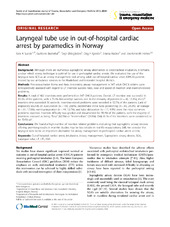| dc.contributor.author | Sunde, Geir Arne | en_US |
| dc.contributor.author | Brattebø, Guttorm | en_US |
| dc.contributor.author | Ødegården, Terje | en_US |
| dc.contributor.author | Kjernlie, Dag Frode | en_US |
| dc.contributor.author | Rødne, Emma Sjøgren | en_US |
| dc.contributor.author | Heltne, Jon-Kenneth | en_US |
| dc.date.accessioned | 2014-10-13T14:09:03Z | |
| dc.date.available | 2014-10-13T14:09:03Z | |
| dc.date.issued | 2012-12-18 | eng |
| dc.identifier.issn | 1757-7241 | |
| dc.identifier.uri | https://hdl.handle.net/1956/8634 | |
| dc.description.abstract | Background: Although there are numerous supraglottic airway alternatives to endotracheal intubation, it remains unclear which airway technique is optimal for use in prehospital cardiac arrests. We evaluated the use of the laryngeal tube (LT) as an airway management tool among adult out-of-hospital cardiac arrest (OHCA) patients treated by our ambulance services in the Haukeland and Innlandet hospital districts. Methods: Post-resuscitation forms and data concerning airway management in 347 adult OHCA victims were retrospectively assessed with regard to LT insertion success rates, ease and speed of insertion and insertion-related problems. Results: A total of 402 insertions were performed on 347 OHCA patients. Overall, LT insertion was successful in 85.3% of the patients, with a 74.4% first-attempt success rate. In the minority of patients (n = 46, 13.3%), the LT insertion time exceeded 30 seconds. Insertion-related problems were recorded in 52.7% of the patients. Lack of respiratory sounds on auscultation (n = 100, 28.8%), problematic initial tube positioning (n = 85, 24.5%), air leakage (n = 61, 17.6%), vomitus/aspiration (n = 44, 12.7%), and tube dislocation (n = 17, 4.9%) were the most common problems reported. Insertion difficulty was graded and documented for 95.4% of the patients, with the majority of insertions assessed as being “Easy” (62.5%) or “Intermediate” (24.8%). Only 8.1% of the insertions were considered to be “Difficult”. Conclusions: We found a high number of insertion related problems, indicating that supraglottic airway devices offering promising results in manikin studies may be less reliable in real-life resuscitations. Still, we consider the laryngeal tube to be an important alternative for airway management in prehospital cardiac arrest victims. | en_US |
| dc.language.iso | eng | eng |
| dc.publisher | BioMed Central | eng |
| dc.rights | Attribution CC BY | eng |
| dc.rights.uri | http://creativecommons.org/licenses/by/2.0 | eng |
| dc.subject | Out-of-hospital cardiac arrest | eng |
| dc.subject | Intubation | eng |
| dc.subject | Airway management | eng |
| dc.subject | Supraglottic airway device | eng |
| dc.subject | SGA | eng |
| dc.subject | Laryngeal tube | eng |
| dc.subject | LT | eng |
| dc.subject | LTS | eng |
| dc.subject | EMS | eng |
| dc.title | Laryngeal tube use in out-of-hospital cardiac arrest by paramedics in Norway | en_US |
| dc.type | Peer reviewed | |
| dc.type | Journal article | |
| dc.date.updated | 2013-08-23T09:00:22Z | |
| dc.description.version | publishedVersion | en_US |
| dc.rights.holder | Copyright 2012 Sunde et al.; licensee BioMed Central Ltd. | |
| dc.rights.holder | Geir A Sunde et al.; licensee BioMed Central Ltd. | |
| dc.source.articlenumber | 84 | |
| dc.identifier.doi | https://doi.org/10.1186/1757-7241-20-84 | |
| dc.identifier.cristin | 995675 | |
| dc.source.journal | Scandinavian Journal of Trauma, Resuscitation and Emergency Medicine | |
| dc.source.40 | 20 | |

